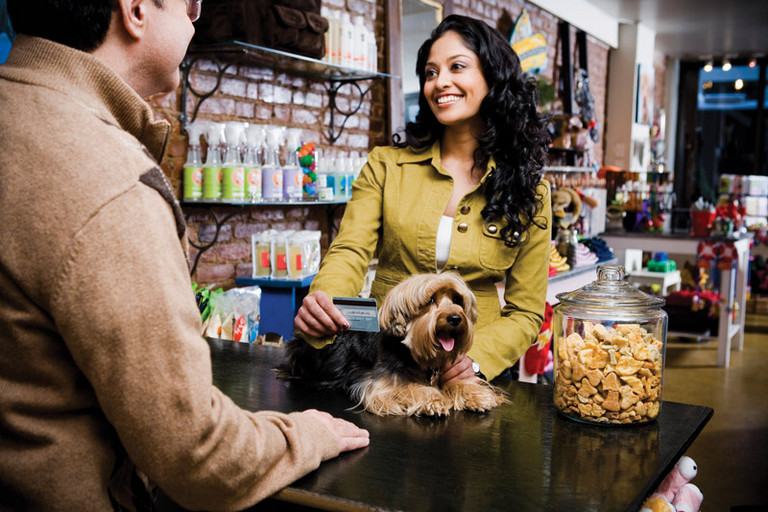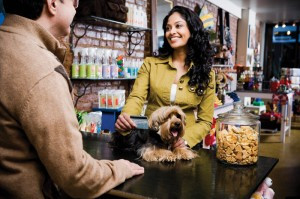Catching Their Eye
Pet Age Staff //October 1, 2013//
They call it a pet supply store for a reason. It’s not where you go to buy stuff for yourself.
Yet the fact remains that it’s humans who are making the purchasing decisions, and it’s humans who are laying out the money. With that in mind, you might think that offering some sort of products for use by people could be a useful part of a pet supply store’s profit strategy.
People don’t walk into pet stores with the idea that they’re about to buy anything for themselves. They’re there specifically to get what they need for their pets. So a human-oriented product not only has to catch their attention, but it also has to appeal to a mind that was focused on something else before it even walked into the store.
For Maranda Ward, marketing manager at Madison, Wis.-based Animart, an unsuccessful first attempt to promoting human-oriented products doesn’t mean the idea can’t work.
“If we market them differently, or we present them in different ways, it’s something we can make work for us,” Ward said.
Know the Market
Sometimes the failure of one product can lead to the gem of a new, relationship-building idea. When Animart tried selling books, it did not have success, but the reason had more to do with the nature of the information and other ways people can get it.
“We had educational books on different breeds, or on fish,” Ward said. “They didn’t sell very well, and that’s because a lot of people are using the Internet instead. So we built up an online resource of our own to refer people to. We also made our own literature instead of books.”
For Tyson Keane, co-owner of Grand Rapids, Mich.-based Chow Hound Pet Supplies, inventory management is one of the challenges in making people products work.
“We have dabbled in and out of it over the years,” Keane said. “The toughest thing is to keep your offerings fresh without having to discount too much of your inventory to make space for something new. Our regular customers get tired of seeing the same items after about 6 months. You have to keep rotating new items in to catch their attention. After you sell off the remaining inventory at or below cost it’s hard to justify the space and effort.”
Meg Bashore of Lansing, Mich.-based Soldan’s Feeds and Pet Supplies agreed that people products haven’t proved to be a major source of customer attraction or sales.
“We are known more for our selection of supplies and quality pet foods, so when we do have them, they are absolutely an impulse buy and an add-on sale for most consumers who purchase them,” Bashore said. “It is always a game of trial and error, so we try to keep something in the store that is new and fresh for the consumer. But being as it has never been a huge profit area for us, we choose to keep it at a minimum of what, and how much, we sell of it.”
One product that several sources mentioned as having had some modest success was calendars. Given a pet-related theme, calendars are often desired as a wall adornment, and they’re not terribly expensive as an add-on purchase.
“The short time on the shelf helps the displays get noticed,” Keane said. “We usually only carry them for about 3 months. Many calendar makers will buy your unsold inventory back so you preserve your margin on what you sell.”
Merchandising strategies present a challenge as well, since pet supply stores by nature will have a hard time giving prominent floor space over to people products when that is not the primary mission of their story.
Ward said Animart sees some potential with greeting cards, as well as special occasions in which portrait artists will visit the store and offer to develop portraits, which might include entire families including the pet, or just the pet.
Gift Giving
And what about gifts? Given the chance to cross a fellow pet-lover off a Christmas list, could pet-related gifts also create an opportunity?
“I think, around the holidays, retailers are able to offer gifts not for pets but for the pet lovers, and to use that to their advantage,” Ward said. “Somebody has a dog and somebody’s buying a gift for them that reflects how much they care about their dog.”
If the experience of these pet retailers is any indication, people products can offer some useful add-on, but their unpredictability means it helps if suppliers are willing to buy them back. Don’t expect folks to make your pet store a destination because of people products, though. They come for the pets. If they decide to treat themselves while they’re there, consider it a bonus.
– Dan Calabrese




















